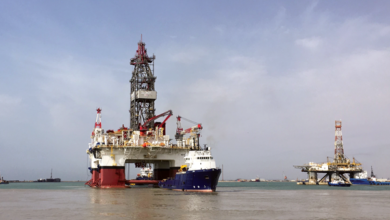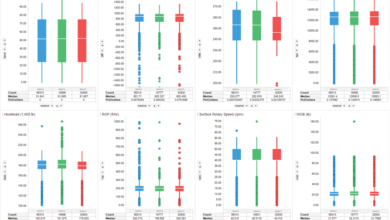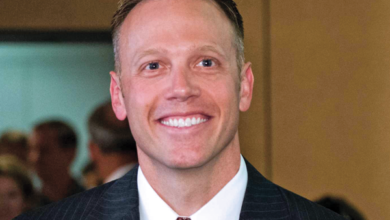Downturn serves as wake-up call for contractors to think differently about industry’s operating model
Bonus incentivizations are a small step, but industry needs new business approach that will allow contractors to be rewarded for innovations, performance
By Linda Hsieh, Managing Editor

Angela Durkin is Chief Operating Officer for Maersk Drilling.
With all the volatility we’re seeing in the market, how can the industry maintain its focus on safety?
I really think that safety needs to be our No. 1 priority. Money or heavy investments are not the solution to safety, or we would have eliminated the problem a long time ago. To keep us safe, we have to focus on the minds and hearts of our people, and we have to build a safety leadership culture. Nobody is born a safety leader, so we have to train people to think about what can go wrong. They need to think about everything surrounding them and all the scenarios that can happen when they take an action.
By nature, our employees try to work as efficiently as possible and to get things done, and sometimes they’re working against time. We need to make sure people are aware of what is most important, and that is the safety of our employees and everyone around them.
How has the industry’s understanding of human factors evolved?
Our industry has come a long way in the last couple of years on human factors. I was always frustrated when I would see a root cause analysis where the conclusion was “not following procedure,” and then the report gets put aside. We really need to look into why the person didn’t follow the procedure. If we’re not understanding why, nothing will ever change. We need to think about what was the underlying cause. People don’t wake up in the morning and deliberately decide not to follow a procedure. They often have in their mind a good reason, and it’s those reasons we need to understand.
We send messages to our employees about needing to get something done, and we also send messages about staying safe. We need to make sure everyone understands that the safety and well-being of the people always come first. We as management need to be very crisp and clear with that message.

There is very low visibility in the offshore drilling market. How does that uncertainty impact the way offshore drilling contractors are managing their businesses?
We certainly need to think more about how we maneuver in this low visibility, which makes it difficult to foresee utilization. We all have to recalibrate to a different price level, and we are still in the process of achieving that in practical terms.
For operators, most of them have been re-planning their projects to fit the lower oil price. They’re adopting changes to aspects like well placement, well complexity, the equipment they use and platform design.
For drilling contractors, we need to continue to bring more efficiency to our clients at a lower cost level, while also looking into completely new operating models.
I believe that this downturn has been a wake-up call for the industry that we do need to do things differently and we do need to work together more efficiently to take cost out of the industry.
Are operators open to changes in the contracting model?
They are generally open, but this is something we need to discuss with individual operators.
How might technology adoption and things like automation be impacted if the industry found new ways to operate?
There are many new technologies that I would like to bring to our rigs, but we simply can’t afford to spend the money because we are not rewarded for it. The dayrate model doesn’t allow us to make that investment because we won’t get a return. This means the operator has to step in to make that investment if they really require the technology, and I don’t think that is the optimal way to operate in our industry.

Technology on the rigs should not be driven only by the customer. The drive to automation is not just increasing efficiency; it’s also increasing our safety performance. The fewer people we have near heavy machinery, the fewer people are in harm’s way.
I compare our situation to that of service companies about 15 years ago. They were also being compensated on dayrates, but when they developed more efficient tools, all of a sudden they were drilling the same section in half the time. While the dayrate increased for the new tools, it didn’t double. So if they were drilling in half of the time, they were getting maybe two-thirds of the revenue they used to get. That didn’t make sense, and you see that models have been changed on the service side where compensation is now measured in, for example, meters drilled or other performance metrics. That’s the kind of thinking that we need to look into as drilling contractors.
It seems like we are already seeing more of the performance-based contracts going around now.
We have seen some bonus-type incentivizations, and it’s a first step, but it’s a small step. At the end of the day, our goal is to drill as efficiently as possible at the lowest cost possible. We need to work with our customers to help them achieve their goals. Otherwise, there will be no work for us. But we all have to find a way to live at a different price point because what we’re doing now is not sustainable. We have already seen a few drilling contractors go out of business, and there will be more if nothing changes.
Would operators have to drive the change because they are the ultimate customer?
Not necessarily. In the example with the service companies, it wasn’t the operator who changed the model. It was service companies taking a much more active role in figuring out the next step in innovation and technology. Of course, they did it with input from operators, but they had a much higher drive.
What would be the value for operators if they were to change the compensation structure?
They would be de-risking their projects, and they also get rewarded for efficiency and for bringing production on stream faster.
There’s a lot of talk about big data in the industry. How can we better use the data we collect at the rig site?
If you look at the cost of running a rig, it’s the people and the maintenance that make up most of the costs. If we can get significantly better in automation, we can reduce the number of people required. This will also positively impact the safety. With fewer people onboard, there is less risk of someone getting hurt. We can also get significantly smarter around maintenance – condition-based maintenance, for example. Both of those concepts require data and are data-driven.
The industry has been discussing MPD technologies for a long time. Its use has grown, but it’s still not widespread. What do you see for the future of MPD technologies?
I see it as a technology that’s going to be used more and more, simply because of the types of wells we are drilling. We are going into more technically challenging areas, which means that drilling margins are significantly smaller. MPD is an enabling technology for projects that otherwise you can’t drill safely. From that point of view, I do see a significant increase in MPD uptake.
Do you see any movements from contractors to equip drilling rigs with MPD so that the technology is ready to deploy at all times?
In our case, we now have our first rig that is fully equipped with an MPD system that we own. In the past, it was always based on customer requirement, so we would install the system, take it off, install it again, and take it off again. That’s certainly not the most effective way of doing it. From an industry standpoint, I think you will see more and more rigs being permanently equipped with MPD systems.
For the rig you mentioned, is the MPD system being operated by Maersk Drilling crews rather than third parties?
Yes, absolutely it is. The system was originally installed on customer request, but we took it over and kept it. So it was run by a third party before, but I think it’s significantly easier if it’s run by our people and if we have full ownership of our equipment onboard.
Does this additional capability allow you to charge a premium for the rig?
Not in this market, but it might sway a decision of being selected for a contract or not. Of course, I think it should give us a premium because it is adding significant value to an operator. However, in the current market that is difficult to achieve.
Other than MPD services, do you see drilling contractors integrating more services into the rig site so that fewer third parties have to come out to the rig?
Actually we have seen the trend going the other way in the past decade. We have seen third parties taking more services on the rig, and I don’t think it is a healthy or efficient development. It should be the other way around because quite often we have third parties coming on a rig to perform tasks that could easily be performed by the rig crews. It is time to review and rethink the way we work.
There is still a large oversupply of offshore rigs in the market today. Do you see more rig retirements coming over the next year?
Yes, I think we will continue to see retirements of rigs that are over a certain age and not up to technical standards. If they come up for their five-year surveys and don’t have a follow-on contract, they will likely be retired. Unfortunately, a rig costs money even if you do nothing with it.
What are the challenges with cold stacking more rigs?
First of all, you face huge reactivation fees. Secondly, the industry doesn’t have a lot of experience with reactivating these rigs. We’ve seen it happen with a couple of our competitors, but there are still not a lot of data points available. If you cold-stack a rig, you really take machinery out of operation that’s supposed to be running all the time. You don’t really know to what degree there’s going to be damage, decay, rust, etc. Currently, all of Maersk Drilling’s idle rigs are warm-stacked, but of course we have a preservation program in place.
What other critical challenges do you see on the horizon for our industry?
We have to think more about the future workforce of this industry. We’re going to have a lot of challenges attracting new talent into our industry, and downturns like the one we are in right now are not helping.
There’s truly a high risk of losing talent and not being able to attract them back. I think our industry needs to be aware of this issue because it will become a big challenge down the road. DC




